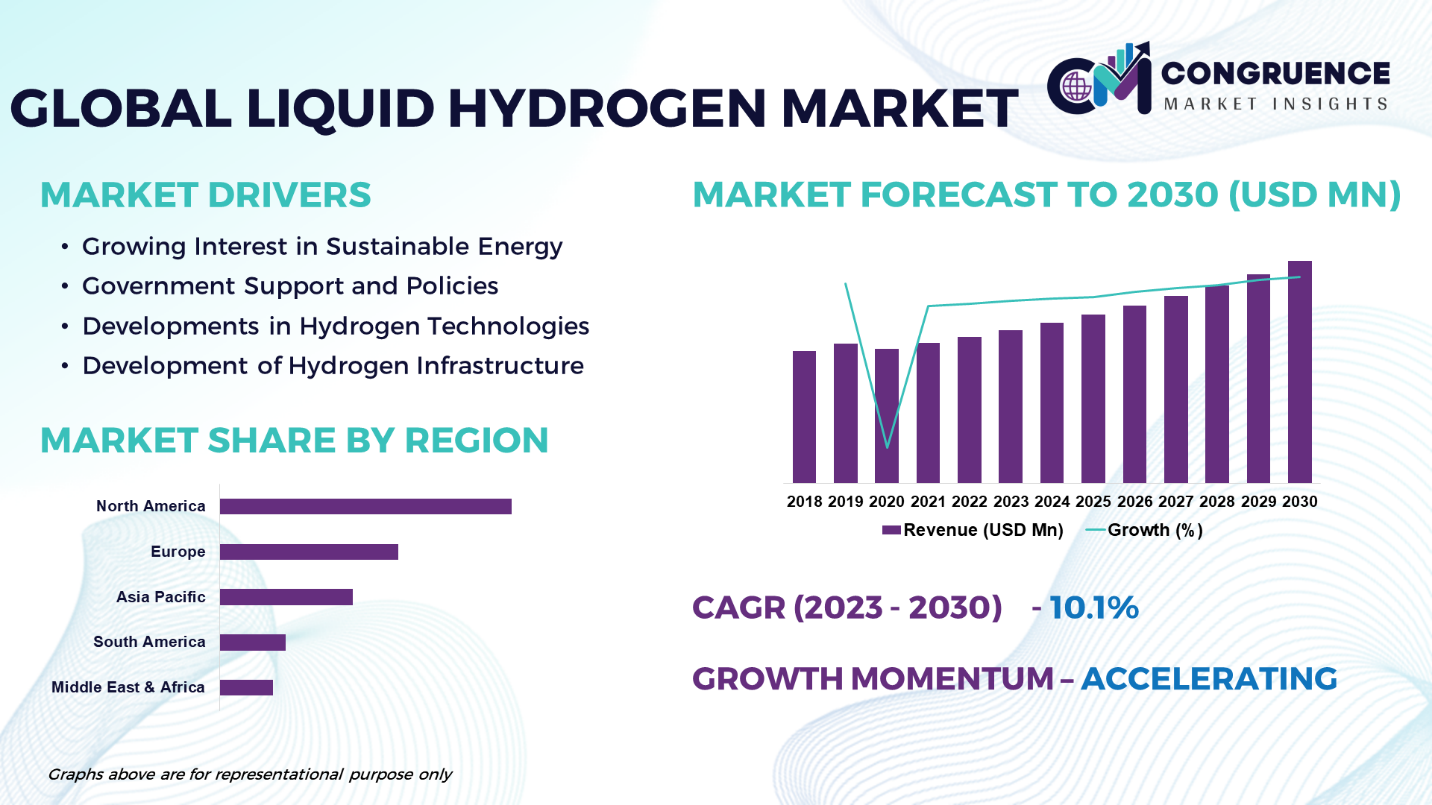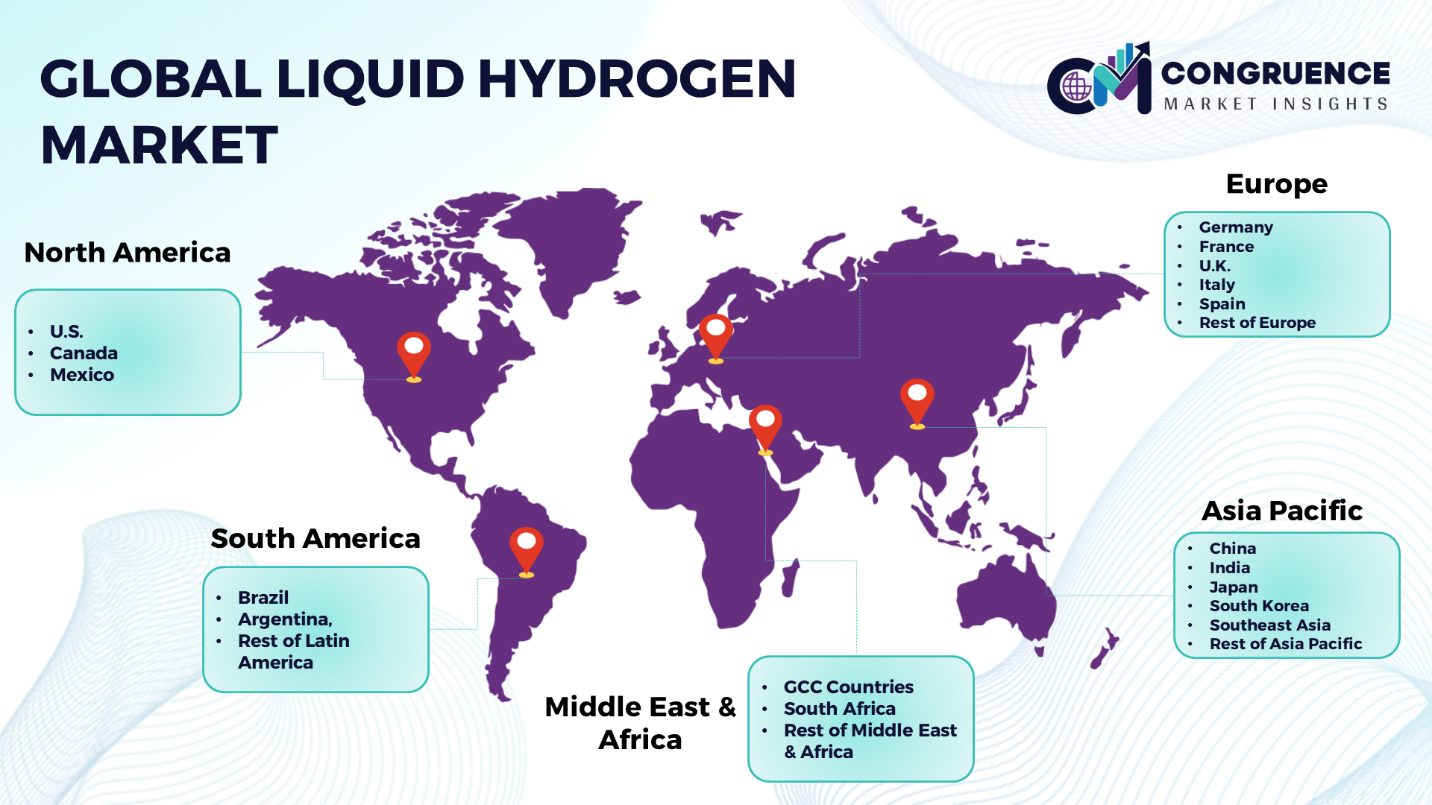Reports
The Global Liquid Hydrogen Market is expected to expand at a CAGR of 10.1% between 2023 and 2030. The potential of the worldwide liquid hydrogen market to revolutionize a number of sectors through clean energy makes it an essential part of the emerging hydrogen economy. Applications for liquid hydrogen, a cryogenic liquid kept at very low temperatures, include industrial operations, space exploration, transportation, and power generation. Liquid hydrogen is a flexible and effective energy transporter. Liquid hydrogen is emerging as a critical facilitator of de-carbonization efforts as the world moves toward a low-carbon future by providing a clean and sustainable substitute for traditional fossil fuels. Liquid hydrogen is a vital component of the answer to reduce greenhouse gas emissions and fight climate change because of its capacity to provide energy through hydrogen fuel cells and combustion processes with no emissions. The market for liquid hydrogen is being pushed by rising investments in hydrogen infrastructure, encouraging regulations from the government, and an increase in the need for sustainable energy solutions in a variety of industries. As a strategic energy vector, governments and international organizations are giving priority to hydrogen and contributing funding for the development, implementation, and study of hydrogen technology. Transportation, including fuel cell electric vehicles (FCEVs) and hydrogen-powered buses, lorries, and trains, is one of the main uses for liquid hydrogen. The demand for liquid hydrogen as a transportation fuel is being driven by advances in fuel cell technology and infrastructure related to hydrogen refueling. Fuel cell electric vehicles (FCEVs) provide zero-emission mobility options with extended driving ranges and rapid refilling times.

Liquid Hydrogen Market Major Driving Forces
Growing Interest in Sustainable Energy: Utilizing liquid hydrogen in fuel cells results in just water vapor, making it a sustainable and clean energy source. The market for liquid hydrogen as an alternative to conventional fossil fuels has been pushed by the rising concern about greenhouse gas emissions and the switch to cleaner fuels on a worldwide scale.
Government Support and Policies: The liquid hydrogen market is stimulated by investments, which in turn promotes the industry's growth and development. These policies, incentives, and subsidies are designed to promote hydrogen as a clean energy carrier.
Developments in Hydrogen Technologies: The economy and efficiency of liquid hydrogen applications are enhanced by continuous developments in hydrogen generation, storage, and use technologies, such as electrolysis, liquefaction, and fuel cell technologies.
Development of Hydrogen Infrastructure: The widespread use of liquid hydrogen depends on the development of a strong hydrogen infrastructure, which includes facilities for production, storage, and delivery. The market for liquid hydrogen is mostly driven by investments in infrastructural expansion and technological developments.
Liquid Hydrogen Market Key Opportunities
Integration of Renewable Energy: Electrolysis may be used with renewable energy sources such as solar and wind power to make liquid hydrogen. The production of green hydrogen using renewable electricity is anticipated to rise in tandem with the growing amount of renewable energy in the power generating mix, propelling the demand for liquid hydrogen.
Hydrogen Refueling Stations: To support the broad implementation of hydrogen-powered transportation solutions, there is a substantial opportunity to grow the network of hydrogen refueling stations, especially in areas where fuel cell electric vehicles (FCEVs) are widely adopted.
Renewable Hydrogen Production: Growing interest in producing hydrogen sustainably by electrolysis with renewable energy sources offers prospects for the construction of large-scale electrolysis plants that will generate green hydrogen for use in liquid hydrogen applications.
Liquid Hydrogen Market Key Trends
· Increasing investment in hydrogen infrastructure development.
· Growing adoption of liquid hydrogen as a clean energy carrier.
· Expansion of hydrogen refueling station networks to support fuel cell electric vehicles (FCEVs).
· Rise in renewable hydrogen production through electrolysis using renewable energy sources.
· Integration of liquid hydrogen with renewable energy projects for grid stability.
· Diversification of industrial applications for liquid hydrogen, including chemical manufacturing and refining.
· Transition to hydrogen-powered mobility solutions across transportation sectors.
· Advancements in liquid hydrogen storage and distribution technologies.
· Collaboration between aerospace companies and government agencies for space exploration missions.
· Emergence of hydrogen-based synthetic fuels production using liquid hydrogen as a feedstock.

Market Competition Landscape
The competition in the liquid hydrogen industry is vigorous and ever-evolving. A plethora of entities, ranging from established industry titans to innovative startups, contend for domination and market share. Competitive rivalry fosters a continuous quest for innovation and outstanding achievement as businesses endeavor to differentiate themselves by means of superior quality and client contentment. Variables including new developments in technology, changes in regulations, and shifting customer tastes all influence market dynamics. In addition to pushing market expansion, this dynamic rivalry presents possibilities and challenges for players, encouraging strategic alliances, mergers, and acquisitions as companies try to stay ahead of the curve in this ever-changing landscape. Generally speaking, the liquid hydrogen industry offers an exciting range of competition, where success depends heavily on one's capacity to adapt and generate new ideas.
Key players in the global liquid hydrogen market implement various organic and inorganic strategies to strengthen and improve their market positioning. Prominent players in the market include:
· Air Products and Chemicals, Inc.
· Linde plc
· Air Liquide S.A.
· Praxair, Inc. (a subsidiary of Linde plc)
· Mitsubishi Chemical Corporation
· Air Water Inc.
· Messer Group GmbH
· Taiyo Nippon Sanso Corporation
· Iwatani Corporation
· Hydrogenics Corporation (a subsidiary of Cummins Inc.)
· Nel ASA
· Plug Power Inc.
· ITM Power plc
· Ballard Power Systems Inc.
· Green Hydrogen Systems A/S
|
Report Attribute/Metric |
Details |
|
Base Year |
2022 |
|
Forecast Period |
2023 – 2030 |
|
Historical Data |
2018 to 2022 |
|
Forecast Unit |
Value (US$ Mn) |
|
Key Report Deliverable |
Revenue Forecast, Growth Trends, Market Dynamics, Segmental Overview, Regional and Country-wise Analysis, Competition Landscape |
|
Segments Covered |
· By Production Method (Steam Methane Reforming, Electrolysis) · By Storage Technology (Cryogenic Storage, Material-Based Storage) · By Application (Transportation, Power Generation, Industrial) · By End-user (Automotive, Aerospace, Energy, Chemicals) |
|
Geographies Covered |
North America: U.S., Canada and Mexico Europe: Germany, France, U.K., Italy, Spain, and Rest of Europe Asia Pacific: China, India, Japan, South Korea, Southeast Asia, and Rest of Asia Pacific South America: Brazil, Argentina, and Rest of Latin America Middle East & Africa: GCC Countries, South Africa, and Rest of Middle East & Africa |
|
Key Players Analyzed |
Air Products and Chemicals, Inc., Linde plc, Air Liquide S.A., Praxair, Inc. (a subsidiary of Linde plc), Mitsubishi Chemical Corporation, Air Water Inc., Messer Group GmbH, Taiyo Nippon Sanso Corporation, Iwatani Corporation, Hydrogenics Corporation (a subsidiary of Cummins Inc.), Nel ASA, Plug Power Inc., ITM Power plc, Ballard Power Systems Inc., Green Hydrogen Systems A/S |
|
Customization & Pricing |
Available on Request (10% Customization is Free) |
